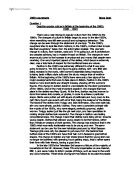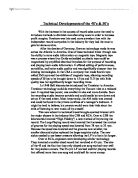In the late 1950’s the Television Set became a fixture of the majority of households in the UK. However, these TVs only broadcasted on one channel, BBC 1, and were mainly to inform people of things, such as news in the world and documentaries. These kinds of programmes helped to educate the people of the fifties. In the fifties most programmes still aimed to instruct the viewers; and with only one channel, whatever was shown was incredibly influential on the viewers. Significant events then began to be broadcasted on BBC 1, such as sporting events and the Queen’s Coronation. In 1955 ITV was introduced. This channel provided commercials for the viewers and was a channel purely with entertainment. This resulted in BBC 1 no longer being as popular. By the early 60’s popular culture in Britain was still dominated by the older generation. Regional accents were almost unheard of on TV until the biggest accomplishment so far was broadcasted, Coronation Street on ITV and Z Cars on the BBC. Both the programmes were at first criticised for their content and also for their effect on the viewers. They portrayed life as it was, rather than life as it could be. This was to be an increasing trend on television in the Sixties. This is what people wanted to watch at the time, hence why they became so popular with the younger generation. Music channels were also introduced onto the TVs – meaning it is aimed towards the youth of the day. ITV also began to show “Ready, Steady, Go” which was a success overnight, and it was a disaster if it was missed for any reason. People had never had programmes like this before, which is why it was so amazing when it was broadcasted, and why it was so bad to be missed. BBC tried to keep up with the culture by presenting “Top if the Pops”, however this took a lot longer to become successful. Television changed in a huge way, with it turning controversial, compared to educational in the 50’s, meaning that the programmes were aiming to please and influence the audience. The target audience had also transformed greatly, changing from the old to the young. People quickly came dependant on TV, and it was considered a disaster if certain programmes were missed.
Pre 1960’s saw cheap, portable radios, which easy to listen to music and family shows, for example concerts, plays etc, broadcasts which were suitable for all. At the beginning of the 1960’s radio paid little attention to pop music. It was still aimed towards the “older generation”. So, the only way of hearing hit records was to tune into Radio Luxembourg on the Medium Wave. Even though Radio Luxembourg had an appalling signal teenagers still listened to it, as it was the only way for them to hear pop music. Then in 1964 Radio Caroline began broadcasting. This was a pirate radio, meaning it was a ship moored outside the British territorial waters that player non-stop pop music. Pirate Radio became very popular with the teenagers, who could hear non-stop pop music for the first time, but tremendously unpopular with the BBC and the government, who tried to have them banned. The appeal of Radio Caroline was not only the music, but also that fact that it was a radio station that was completely designed for young people. The arrangement of programmes and the presenters were completely different from anything on any other station present. Radio stations also began to set up awards for bands, meaning they are creating great publicity for themselves. There are clear differences between the two decades radio. The radio became aimed towards teenagers and was actually providing what people wanted to listen to – even if it was illegal. Radio became a much more popular feature in the 60’s and the publicity for the radio increased dramatically. The change in types of music appealed mainly to the younger generation of the 1960’s. The thought of listening to something that was actually illegal excited them, and inspired them to become what they later did.
Movies had a large influence on people in the 50’s, 60’s and still today. However things were extremely different in the 50’s. A theatre on contained one movie screen. Never the less, there were still a range of movies being broadcasted to the public, with Rock & Roll, Poetry and prose about family, love life and sad realities of life. The theatre had more American films showing; rather than British films, the USA dominated the cinema. Successful American films in the 50’s included “Ben Hur” and “The Longest Day”. American films were made with vast budgets and huge numbers of extras. With the first two told classical or biblical stories. Meaning they were intended to appeal to mass audience and they did. In the 1950’s blacklisting of many actors happened; for example: Chayefsky, Charlie Chaplin and Dalton Trimbo – who all fled to Europe. January 19th 1959 also saw the release of Disney’s “Sleeping Beauty”, after nearly a decade in production. Many British films did not really portray “real life”. They had story lines about middle class people living prosperous life-styles. They described Britain that people wanted to live in, rather than the Britain that they actually did live in. The films rarely dealt with the problems that ordinary working people had to contend with, such as unemployment and poverty. But that was all about to change in the Sixties. The 60’s saw the increasing decline in the studio system in Hollywood, and the increase in films being made in new locations; for example: “Pinewood” in England and “Cinecitta” in Rome. The target audience of films being produced also change, with them being geared more towards families; such as “Mary Poppins” and “My Fair Lady”, which were released in 1964, and “The Sound of Music”, which was released in 1965. Due to the increasing decline in Hollywood American films were no longer as good, meaning space was made for British and European producers and directions. The 1960’s film industry was also responsive to political and social issues surfacing Britain and America. This meant that in the 60’s a wider range of films were available, and they were targeted towards everyone, with more British and European films coming into production. Cinema in the sixties reflected the decade of fun, fashion and incredible social change. The sixties saw the film industry change forever. During the period a number of lasting changes took place, including a relaxing or censorship laws, an end to the studio system in Hollywood, television taking centre stage in the mass culture and the emergence of a new type of actor. Some of the foundations needed for these dramatic and lasting changes were laid in the fifties and as movie audience figures began to decrease the film industries in both Britain and especially in America had to change their systems, their strategies and ultimately their attitudes. The sixties were therefore, as Quart and Auster state in American Film and Society since 1945, a driving ‘force for renewal and transformation’.
The culture of going out and socialising at parties also changed; with the types of dancing changing significantly between the 50’s and the 60’s. The people of the 1950’s saw swing and rock and roll dance. Meaning that it was almost essential to have a partner, especially in swing – where your partner is throwing you around. Where the people of the 1960’s saw different types of dance, with twist – ballroom dancing, and the locomotion. In the 1960’s it became a lot more independent, meaning that people didn’t have to go with a partner. Dance routines became a lot quicker and more independent, which clearly links into the music and fashion changes that have also taken place, where people will do their own thing. This affected the youth massively; the fact that it was more independent and faster meant that more youth wanted to get involved and felt as though it was geared more towards what they wanted, not the older generations of their time.
People and their opinions changed significantly during this cultural change. In the 50’s teenagers did as they were told by their parents, and followed the rules exactly. By the 60’s this changed dramatically, the teenagers were now doing as they wanted, whether it was allowed or not. The older generation were still back in the 50’s, but that didn’t matter! People were more independent, and that was never going to change back. What was being shown on TV had a great part to play in these changes as youngsters were being encouraged to lead their own lives. Other things also contributed; such as the pirate radio stations – as they were illegal, it gave people the idea that it was ok to do some wrong now and again.
In conclusion, the cultural change between the 1950’s and the 1960’s in Britain was extraordinary! It began with everyone doing as they were told, following their parents in the 1950’s to a mass rebellion in the 1960’s. People finally realised that it was their life, and it was up to them what they did with it. The films, TV programmes, and music that were around at the time had a huge part to play in this change, as they were largely influencing people into doing things they would never have thought of before. Overall, the changes in the 60’s were positive, as it made everyone more independent and free minded, except for the older generation, who were stuck in 50’s.







